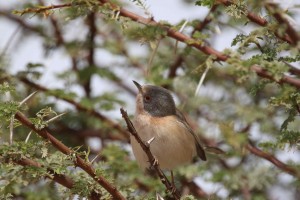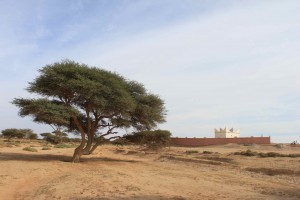
Morocco is situated in the northwest corner of Africa, between c 21° and 36° N, and is basically an African country with a large Mediterranean region. Except for the extreme south that is part of the Sahara, rains fall mainly during the cool season (October – April), and the summers are hot and dry; drought prevails in the Saharan region throughout the year. Friendly people, great scenery and bird specialities, Morocco is becoming one of the favourite destination for birders in search of endangered or rare species such as Bald Ibis (now the only population in the world), Eleonora’s Falcon, and African Marsh Owl, as well as other species such as Dupont’s Lark, Moussier’s Redstart, Desert Warbler, Black-crowned Tchagra, and Desert Sparrow.
The Country divides into a number of geo-physical regions, and this influences the birds that are found there [see map of regions].
Mountains: 5 ranges are aligned along a NE – SW axis, and these include the Rif along the Mediterranean coast (2456m, Jbel Tidighine), the Central Plateau (1627m, Jbel Mtouzgane), the Middle Atlas (3340m, Jbel Bou-Naceur), the High Atlas (4167m, Jbel Toubkal) and the Anti-Atlas (3304m, Jbel Siroua). Despite high human and animal pressure, forests of broad-leaved and coniferous trees are still widespread.
Atlantic Morocco includes rich agricultural plains and more barren and dry plateaux. Most of the original forest has been turned into matorral – or shrub-type vegetation after intensive cutting and grazing, but some has been well preserved (eg “Forêt de la Mamora” with Cork Oak in the Rharb) however, large tracts of eucalyptus have been planted. The Souss valley, with its unique Argan woodland, lies between the High and Anti-Atlas.
Eastern Morocco, except for the area adjacent to the Mediterranean coast, is dry with especially hot summers and cold winters; the High Plateaux rise to over 1000m and are covered with a steppe type vegetation dominated by Artemisia herba-alba andStipa tenacissima.
Saharan Morocco lies to the south of the High and Anti-Atlas. In the Eastern part, palm oases stretch along the rivers (Oueds) but the region is mainly large stony “regs” (pebble desert) covered with Hammada scoparia; acacias thickets grow along the wadi bottoms. The drought is attenuated in a 15-200 km wide strip along the Atlantic coast, which receives moisture from the ocean; the coast is mainly rocky.
The Birds

454 species have been recorded in Morocco – see complete list and 209 regularly breed there. Most (c 85%) breed north of the Atlas Mountains, because of the moister climate and more diversified habitat, so only about 35% breed in the Saharan region.
Every year, millions of West European migrants go to and pass through Morocco, mainly from late July to early November in the autumn, and from March to May in the spring. Most, especially passerines, migrate by night or over-fly too high to be seen during the day; others, like waders and gulls, often stop at wetlands to refuel, and provide unforgettable sights. The Straits of Gibraltar is famous for concentrating soaring birds, especially storks and raptors.
120 species are regular winter visitors, including 34 that are at the southern limit of their wintering range. 115 other species have been recorded as accidental visitors, either from Europe and Asia (e.g. Great Knot and Pectoral Sandpiper), from Tropical Africa (e.g. Brown Booby and Lesser Flamingo), or from Northern America (e.g. Blue-winged Teal and Laughing Gull).
Birding hotspots
Several wetlands spread along the Atlantic coast that are rightly famous for their migrant and wintering waders and gulls. These include Merja Zerga, Lac de Sidi Bou-Rhaba, Sidi-Moussa-Oualidia lagoons, and the Souss and Massa estuaries along the North coast, Khnifiss lagoon and Dakhla and Cintra Bays along the Saharan coast. The islets off Essaouira shelter a colony of Eleonora’s Falcons. The Mediterranean coast includes two major wetlands: Sebkha Bou-Areg and the Moulouya estuary.
Mountains shelter a rich avifauna; this can be seen best on the Plateau des Lacs in the Middle Atlas (Crested Coot, Levaillant’s Woodpecker, etc.) and at Oukaimeden in the High Atlas (Atlas Shore Lark, Alpine Accentor, Rock Sparrow, & Crimson-winged Finch).
Many desert-living species, including larks, wheatears and sandgrouses, are widespread in desert Morocco; others are more restricted in range, and birding hotspots include the temporary lake of Merzouga near Erfoud (waders and ducks in the desert!) bordered by the only large Moroccan sand dunes, the so-called Erg Chebbi (Desert Warbler, Brown-necked Raven, Desert Sparrow et al), and the Barrage Mansour-Eddahbi near Ouarzazate.
The Straits of Gibraltar is famous for the impressive raptor migration.
There are, of course, hundreds of other sites worth exploring for Ruddy Shelduck, Marbled Teal, Black-winged Kite, Booted and Bonelli’s Eagles, Lanner and Barbary Falcons, Double-spurred Francolin, Purple Gallinule, Houbara and Great Bustards, Cream-coloured Courser, Desert Eagle Owl, Plain Swift, Blue-cheeked Bee-eater, Scrub and Tristram’s Warblers, Fulvous Babbler or Black-crowned Tchagra… so, when you visit, explore for yourselves.
Contacts
Foreign Researchers have frequently asked us where and how to get the necassary permits to do their field work in Morocco: they have to contact the Centre d’Etude des Migrations d’Oiseaux (CEMO, c/o Pr. M. Dakki and A. Qninba) with all the details of their project.
Departement de Zoologie et Ecologie Animale
Institut Scientifique
BP 703, Rabat-Agdal
Maroc
Phone +212 (0) 37 77 45 48 or 49
Fax +212 (0) 37 77 45 40]
Car rentals
Hertz Morocco: ‘The moral of the story don’t use Hertz Morocco particularly as they don’t have any depots south of Agadir which was 800 km north of where we broke down. It is worth mentioning that it appears that most local garages have spare parts for French-made cars but we unfortunately had a VW and the nearest spare parts were 1000+ kms away! Try to get a French hire car’ (Richard, Dec 2012)Agadir : Lahcen, le frère du patron de l’Hôtel Petite Suède, dispose d’une agence de location de véhicules : AMOUDOU Cars, située dans l’immeuble Abdou à l’angle des Avenues Hassan II et el Moquaouama (amoudou.car@laposte.net ; Tél. +212 (0)5.28.82.50.10 / (0)5.28.84.07.79 ; GSM +212 (0)6.61.15.83.21), pas plus chère qu’une autre. Nous lui avons loué une Logan essence en excellent état à 300 DH/jour tout compris, avec assurances, pour 8 jours. Lahcen s’organise pour venir vous attendre à l’aéroport d’Agadir le jour de votre arrivée et de vous y ramener lors de votre départ, gratuitement. Notre meilleure adresse dans la région d’Agadir.
Guides
Brahim Bakass is a professional Birding and Nature Guide based in Marrakech and specialises in taking tours to different areas in the Atlas Mountains and the Saharan desert. Brahim is also active in different associations, for instance he currently serves as the Secretary of the “Groupe d’ornithologie du Maroc” known as GOMAC. Some of his destinations include the High Atlas Mountains, the Anti-Atlas (Tagdilt track, the rest of Jbel Saghro…), the National Parks and lakes of the Middle Atlas, desert areas (Merzouga, Iriki, M’hamid El Ghizlan…), and the oases of Draa and Tafilalt. He also leads “cultural tours” to discover the rich Berber culture in the High Atlas and desert areas (transhumance and pastoral life, Berber Kasbahs, different archaeological sites with rock carvings…). He can be contacted through his new (and still under construction) website http://www.atlas-sahara-biodiversity.com/ or through his Facebook profile.
Massa
- Mohamed Bargache, mobile:+212615885199, sand_piper_bird@hotmail.com, is a nice guide for Massa but also for the rest of the region (for example Oued Souss, Goulimine and High Atlas)
- ‘Pour les guides de Massa, je conseille Rachid Baïtar(00212 71 18 41 37) ou son frère Hamed, ces deux là sont les meilleurs du site, et connaissent parfaitement toutes les ressources ornitho du secteur. En plus ils sont très friands et demandeurs d’informations et de connaissances globales sur les piafs, utiliser leurs services, c’est aussi leur rendre un service…’ (CF, avril 2007)
Avril 2013 : j’ai revu Hamed à Massa, il était en pleine forme. Vous pouvez le contacter sur ahmed.baitarornitho@laposte.net ou au 0676036829
- French-, German- and English-speaking guide Lahsen Ahuilat ben M’bark (Sidi R’bat, flamingo_290@hotmail.com, ‘phone 00212 648108016) ‘Thank you again for giving us Lahsen’s name. We had a great time birding in Morocco. He was a really good guide in Massa’ (B & E. Herzog, January 2011, see the flyer)
- Vous pouvez aussi vous adresser à Lahoucine Oussouilah, holine_massa_8@hotmail.fr
Tafilalt, Erg Chebbi
- ‘El dueño del albergue La caravane (Ibrahim), famoso guía local, nos dijo que por 100 Euros, de noviembre a mayo, nos aseguraba enseñarnos al amanecer hubara. Si no se ve no se paga…’ (OG, December 2006). ‘Ibrahim, the owner of Auberge Le Caravane which is situated about 1 km from the famous Auberge Yasmina, is said to be one of the most reliable guides for the Houbara Bustard. Phone 00212 666 039175, kadi1974@hotmail.com’ (EA, April 2010)
- ‘We made our way to Rissani, where we met our guide Brahim Mezane (phone 00212 670181130, desertbirds.live.fr), a young and enthusiastic local’ (EA, April 2010)
Merja Zerga: ‘El guia ornitologico Hassan Dalil nos ofrecio por 300 DH (30 Euros), ver la Lechuza mora…’ (OG, December 2006)
Marrakech, High Atlas
- J’ai souvent donné l’adresse de Mohamed Zaki (Village d’Ifrane, BP 11 – 22450 Tabant, Azilal – Maroc / phone +212 666 56 9392 / zakimohamed@yahoo.fr / www.zakitour.com à des ornithologues souhaitant un guide dans la région de Marrakech et du Haut Atlas.
- Mohamed Aït Tadrart (BP 51 – 42150 Asni Marrakech – Maroc / maittadrart67@hotmail.com. www.maroctrek.comm) m’a aussi été cité.
- Laurène (septembre 2008) conseille Samir (samirvoyage@gmail.com) pour l’organisation de treks.
- Pierre (juin 2011) conseille un guide professionnel de grande confiance, Mohamed Aït Tadrart (www.maroctrek.com), qui l’a accompagné lors de ses périples de 1996, 1999, 2002 et 2004 dans le Sahara marocain et avait organisé sa randonnée de 2006 sur le littoral atlantique au sud d’Essaouira. Mohammed organise aussi bien des randonnées pédestres (bagages portés par mulets ou par dromadaires selon les terrains parcourus) que des méharées (une part importante du déplacement se fait à dos de dromadaire) ou des circuits en 4×4 (plus cher bien entendu, et bien moins eco-friendly)
High Atlas, massif du M’Goun, Ouarzazate
- Ismail El Allaoui peut être contacté au +00212642577736 ou à salamher@yahoo.fr. Ismail enseigne dans un village du magnifique massif du M’Goun ; il est passionné par les rapaces et saura vous guider dans vos excursions. N’hésitez pas à le contacter.
Birding excursions at sea
Benoit and the GOMAC always go with Captain Jamal at Agadir (tel : 06 76 08 01 76). The trip usually is from 8 AM to 3 PM and goes 20 miles offshore Agadir; Jamal asks 6500 Dh (600 euros).

I will be in Morocco in 2 weeks and would like to find laminated identification cards. Do you know of a source?
Hi Patti,
not sure whet you mean by ‘laminated ID card’ ?
I would like tot upload a (birding) trip report on our visit to Southern Morocco and the Western Sahara early this year. Can you tell me how to do this?
Just send it to me (pbergier@yahoo.fr) and I’ll upload it. Thanks in advance
Mon ami Mohamed Zaki est hélas décédé il y a quelques mois…